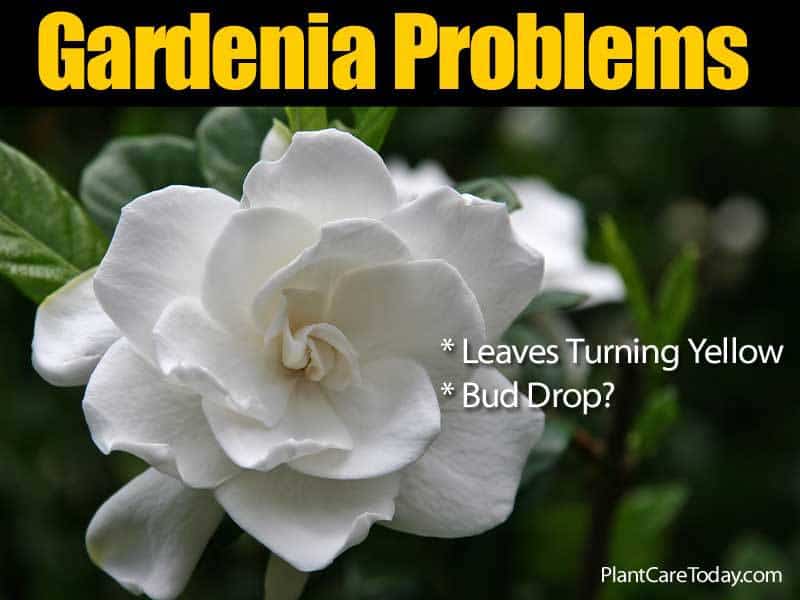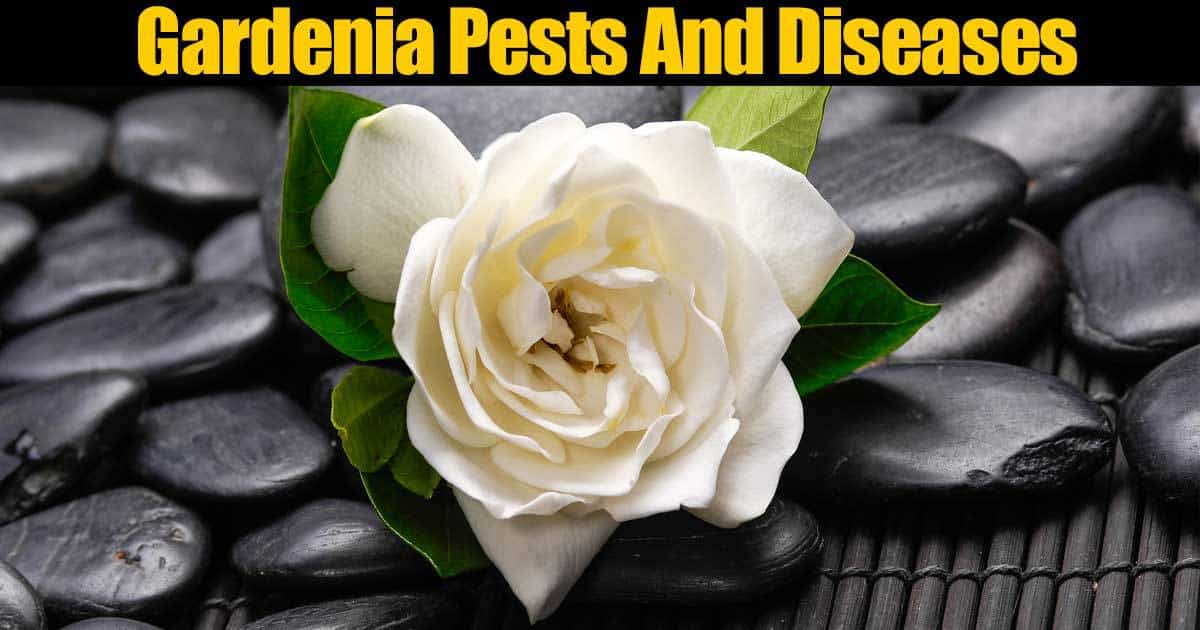Summary: Below is a series of Gardenia pests and disease problems homeowners may experience.

Why Do Gardenia Leaves Turn Yellow?
The Gardenia plant (Gardenia jasminoides) makes a great addition to any garden. Gardenias are adaptable shrubs with fragrant flowers and handsome foliage.
Maintaining gardenias is not an easy task. Mishandling would put them at risk of dying.
Yellowing and dropping of Gardenia leaves have several possibilities:
- Nutritional deficiency
- Low humidity
- Overwatering
Related: Gardenia Leaves Turning Yellow
Yellowing Leaves From Nutritional Deficiency
Gardenias lacking magnesium or iron may show stunted growth and develop yellow or discolored leaves.

Gardenias needing fertilizer show signs of:
- No buds or buds falling off
- Yellow spots on the leaves
- Yellowing starting from the outer edges and spreading inward
- Pale and bleached appearance
- Dropping of older leaves
If there are no flowers or buds – feed these acid-loving plants with an acid gardenia fertilizer. Do not feed while the tree is blooming or during winter.
Massive Leaf Drop and Yellowing Leaves
Yellow leaves on gardenia in mass followed my leaves dropping, and the problem often is watering – Too Much water. Moreover, too much water can also cause brown leaves.
Other potential stressors that may turn your gardenia leaves brown are rapid drops in temperature, poor soil drainage, very hot weather, and insufficient light.
If the leaf curl, gardenia leaves turn brown, dieback occurs, and the soil is constantly wet. The plant should be removed from the pot immediately. Check the root ball for health, and make sure pot drainage holes are not plugged.
Checking The Roots:
- White healthy, looking roots – remove all bad foliage, place back in the pot, and fix watering issues or repot into the fresh new soil.
- Roots damaged and partially brown – remove bad roots, repot in fresh soil
- Roots are mushy and brown – discard the plant.
Gardenia Leaves Yellowing From Low Humidity
The symptoms of low humidity show up as: flower buds dropping, leaf tips turning brown, yellowing foliage, and gardenia flowers turning brown.
Place the potted gardenia in a tray or bed of moist pebbles. DO NOT allow the pot and roots to sit in water. Spray/mist once or twice per day. In winter, use a humidifier.

Gardenia Bud Drop
Question: The buds on my gardenia plant get about ready to open, then start to turn brown. What can I do to make them bloom?
Answer: This trouble is referred to as a bud drop. The proper culture to prevent bud drop is difficult in a house and often occurs in spite of all precautions in a home greenhouse.
Frequent overhead watering after the buds are set may cause them to drop, but lack of sunlight is the chief cause of bud drop.
With a uniform temperature of 60° to 62° degrees, good light, and high humidity, the chances of bud drop are slight.
A pot-grown gardenia should regularly apply one ounce of iron sulfate or iron chelates to two gallons of water at least once a month to maintain correct soil acidity.
An alkaline soil condition will prevent the buds from opening and is one cause of bud drop. If unsure of the soil pH, gardeners usually conduct a soil test.
Details: 7 Reasons For Gardenia Bud Drop

New Plant Bud Drop
If the buds on a new gardenia plant turn to black and drop off, the issue could be all environmental.
Plants moving from a nursery environment to a garden center and then to the home could “shock” the plant as it is acclimating to new surroundings: low light, warm temperatures in the home, and low humidity can all contribute to bud drop.
Spray-mist daily, and place the plant on a tray of pebbles to increase humidity. Keeping humidity levels by properly spacing plants is also important, as it prevents any bud or leaf drop issues. It will also allow good air circulation that prevents fungus from taking place.
Sooty Mold
Question: I have three large gardenia bushes, about 12 years old. This year there is black mold on the leaves of new growth. How can I rid the bushes of it? CAE, Texas
Answer: One “type” of sooty mold is caused by an airborne fungus. These Gardenia pests usually appear when plants are frequently chilled or wet and improperly ventilated. Better light, more air, and dry foliage when watering are the best preventative. A light spray using oil emulsion such as Volck diluted one to 75 will destroy sooty mold fungi on gardenia bushes.
Question: What causes a sooty, black film on the leaf surface of gardenias?
Answer: This is the “other type” of sooty mold. Whiteflies cause this sticky secretion on Gardenias and scale insects which may be controlled with a horticultural oil emulsion spray.
Syringe plants with water a few days after to wash off the dirty film. Privet and lilac are also attacked by these pests. Other pests that may infest the gardenia plant include spider mites and aphids.
Related Reading:
- How To Get Rid Of Aphids On Gardenia Plants
- Getting Rid Of Sticky Leaves On Houseplants
- Tips on Growing Gardenia Jasminoides
Water & Spraying
Question: I was told that a gardenia plant needs to be watered every other day and sprayed once a week with malathion. What fertilizer suits it best and how much should be applied, and how often? Should it get sun or shade? TZ, Mexico

Answer: The gardenia is a sun lover, but some shade during the hottest part of the day is not harmful. It needs water often enough to keep it from getting really dry when growth is active, but probably not every other day.
A weekly forceful water spray with occasional malathion sprays should keep the plant clean and free of insects.
If your plant is outdoors, a 2-inch layer of peat moss and rotted cow manure over well-drained soil is advantageous.
For healthy gardenia plants, keep the soil moist but don’t overwater to avoid root rot.
If confined in a container, a 5-10-5 slow-release fertilizer could be used either dry at the rate of a level teaspoonful to a 6-inch pot or as a liquid at the rate of 2 teaspoonfuls stirred in one gallon of water. Food may be given to the plant about every three weeks when growth is active.
Propagation
Question: Could you tell me how to start a new gardenia from an old one?
Answer: Tip cuttings 3” or 4” inches long is taken late in the winter and rooted in a mixture of sand and peat. Insert unrooted cuttings in 2” to 1/2-inch pots, and give them a bottom temperature of 70° to 75° degrees Fahrenheit.
If kept moist and in an atmosphere that is not dry, the cuttings will root in about eight weeks.
Normally, gardenias grown outside are attacked by only a few insects and one serious disease.

Gardenia Pests
When root-knot nematodes attack gardenias, the green leaves become chlorotic.
These microscopic worms produce characteristic galls or swellings on the roots. Prevention consists of soil sterilization before planting but using steam or chemicals.
If these pests attack your gardenia plant, you may notice brown spots on the leaves. You can treat it with Neem.
Care should be taken when using any chemical materials since they will kill plants (people, too) when used too close. Once the plants are infested, they should be destroyed, as there is no cure.
Scale Insects
The scale insect is the most common pest attacking gardenias grown outdoors.
Whiteflies and mealy bugs sometimes attack gardenias, too. The black vine weevil rarely causes trouble but is serious when it does.
Thrips can also be bothersome, especially when gardenias are grown near a field of weeds.
Black scale can be a real pest. Each scale is about the size of a small split pea, dark brown to black, and nearly hemispherical with a conspicuous H-shaped marking on the back.
The honeydew secreted attracts fungi which in turn give the leaves and stems a black, sooty appearance. This also attracts ants which help spread the scale.
In Florida and the Southeast, the scale pest is the Florida wax scale, reddish or brown and the size of a pinhead.
Orthezia sometimes attacks gardenias grown outdoors; they are small, long, and white, with long stripes on their backs. You will need a hand lens to see them.
All the scales are sap-sucking, and some inject poison. The soft brown scale can be a serious pest at times. too.
It is greenish-brown, oval-shaped, rather flat, and about 1/8 inch long. It infests leaves and limbs and produces a honeydew like the black scale.
The treatment for all scales is a summer oil spray applied at two-week intervals using a 2 percent oil, Malathion can be used as well, but I prefer oil.
Water plants well one half-hour before spraying and again syringe with water an hour after spraying.
Thrips
Thrips and tobacco thrip are also common gardenia pests. Injury is manifested by the silvering of the leaf because the thrips suck the plant juices.
You will need a hand lens to see them on the underside of the leaves as they are very small flying insects.
Clean up all weeds which harbor them.
Mealy Bug
The citrus mealybug is usually found on greenhouse gardenias but sometimes attacks those grown outside.
A hard, sharp syringing with a small water spray usually keeps the citrus mealybugs under control in many vegetable gardens.
Otherwise, use a 2% percent summer oil and a teaspoonful of Malathion for each gallon of water.
White Fly
Whiteflies are quite small, about 1/16” inch long. The adults are pure white and, when disturbed, fly away from the underside of the leaf where they feed.
The larvae look like very small mealy bugs. Both adult and immature stages are found together. For outdoor control, use organic natural neem oil sprays (natural) or Malathion (chemical).
Red Spider Mites
Tiny red plant spider mites sometimes attack the plants in late summer, especially when the air gets – hot and dry.
You will need a hand lens to see the reddish spider mites, which can be controlled by regular hard syringing with cold water.
Do not become alarmed by our mention of all these insects – your plants may never be attacked by any of them, but it is best to be aware of them if they do.
Gardenia Pest Management
You can use plenty of natural ways to get rid of gardenia pests. One of the most effective and safest ways is using diatomaceous earth or food-grade DE. This natural pest control substance help eradicate a wide array of insects.
Some essential oils, such as neem oil, help solve common pest problems. Peppermint oil wards off squash bugs, parasitic wasps, mites, tomato hornworm caterpillars, beetles, and more.
On the other hand, cedarwood, hyssop, and essential pine oils keep slugs and snails away from your gardenia plants.
Introducing beneficial insects that feed on vegetable garden pests will also help solve the infestation.
Gardenia Diseases
The one disease most often found is phomopsis canker, a fungus disease (ficus trees get this as well).
The first symptom of this disease will be a shrinking of the stem at the soil line. This gradually enlarges, and the whole stem swells and becomes rough and cracked.
Related: What Diseases Do Gardenias Get? | Bugs on Gardenia Plants
The leaves become pale green, then yellow, and many fall. Since the disease enters plants only through wounds, use all possible care not to injure the stem when planting or pruning. There is no known cure to dig and destroy (burning is best) infected plants.
Other known diseases include bacterial leaf spot, or Rhizoctonia that causes browning of the Gardenia leaves. You can remove and discard the infected plant to prevent the spread of disease.
